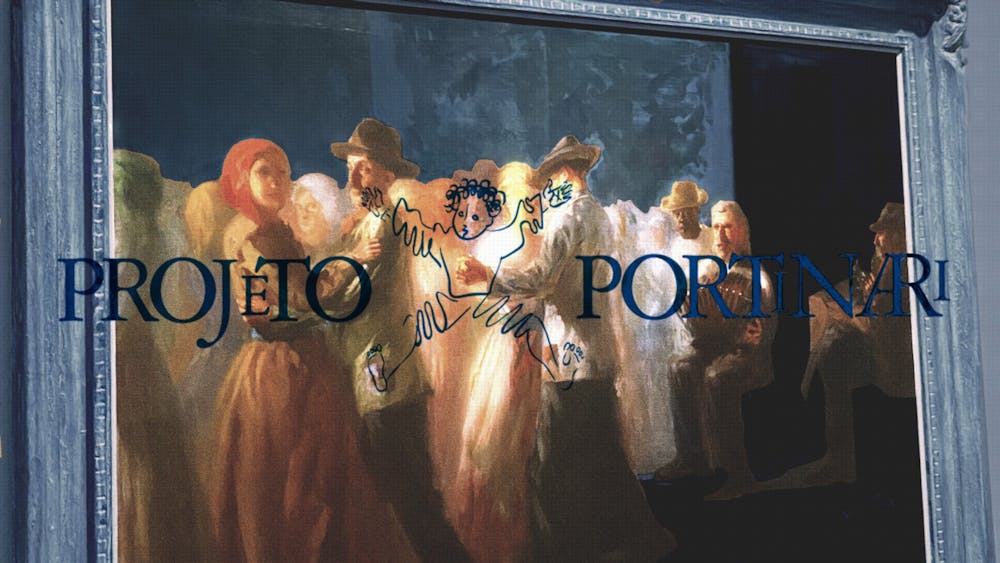Whenever I’m in my hometown, I can’t help but indulge my curiosity and walk into the Centro Cultural Banco do Brasil (CCBB) to explore their newest art exhibition. The historic building is centered in one of the most beautiful places in my city, Belo Horizonte. With its pastel yellow paint and dazzling Greek–style pillars, the tower attracts tourists from all over the country. Throughout the years, the CCBB has become my second home—I know the location of every single bathroom, where every staircase leads, and have taken dozens of pictures on the multicolored glass mural.
The current exhibition in the CCBB is perhaps my favorite one so far. The Portinario Raros Exhibition (Portinari Rare) is focused on the rare artworks of Candido Portinari, a visionary Brazilian artist who stands even now as a celebrated figure in the realm of art history. Portinari is the kind of artist who infiltrated the mind and the imagination of every single Brazilian. His works are in textbooks illustrating inequality’s ghostly face and stamped on the tiles of large buildings and tourist spots around the country.
The exhibit showcases the entirety of Portinari’s career, telling the story of his unlikely beginnings alongside his future widespread acclaim. Born in 1903 in the small town of Brodowski, São Paulo, Portinari was the son of Italian immigrants and grew up on the coffee plantation where his parents worked. He had a poor childhood, in which he only studied until elementary school. Yet even amidst the struggle, Portinari's profound talent catapulted him to international recognition. With a masterful command over color, form, and composition, Portinari crafted a remarkable body of work that captured the essence of the Brazilian people, their fights, and their joys.
Walking along the wooden corridors, I followed Portinari in his early rebellious years in art school to his groundbreaking artistic contributions in various mediums. His black–and–white Cubist portraits, which seemed to defy the boundaries of reality, mesmerized me. As I continued, I was transported through the evolution of his artistic journey, witnessing his exploration of Surrealism, his experimentation with activist art, and his fusion of traditional techniques with modern concepts. As I reach the end of the exhibit, I stood in awe of how Portinari left an indelible mark on the art world, earning him a place among the most influential artists of the 20th century.
The question that kept popping into my mind was: "Hey, is that really Portinari?" Portinario Raros proposes to bring to light the invisible, daring Portinari who ventured into various artistic manifestations far beyond his comfort zone. Beyond his more traditional paintings depicting the life of immigrants workers in the countryside, here we see self–portraits, graffiti drawings and even a sculpture.
Portinari’s works were so omnipresent in my life in Brazil, yet I knew so little about his life and achievements that also represented Brazil to the world. Unbeknownst to me, Portinari was already one of the world's leading painters in 1952 when he received a challenging invitation from the United Nations: to design two panels that would be permanently displayed in the gigantic lobby of their headquarters in New York. His artwork not only tells the stories of a nation, but also transcend time, resonating with universal themes and inspiring generations of artists and admirers alike.
One of the most emotional works here might be O Baile na Roça (The Dance in the Countryside), because it reveals the mind of the young Portinari at the National School of Fine Arts, which was the most conservative place in Brazil at the time.
The School only accepted neoclassical art inspired by European standards, rejecting even Impressionism. In 1923, Portinari submitted O Baile na Roça and a few other portraits to the contest, but the school scratched it out because they didn't appreciate its simple background. Portinari ended up selling the artwork and died without ever seeing O Baile da Roça again. Years later, in the first year of the Portinari Project, the organization managed to find it in Rio de Janeiro in a private collection.
The exhibition, fittingly, does not have a chronological linear exhibition, but rather a hybrid one. Walking along the three floors, visitors can see a mix of physical and digital artworks, aiming to bring the complete assortment of Candido Portinari, in all his diversity. This unique collection of his works shows how Portinari is timeless. He was concerned about issues that continue to be relevant today, addressing immigrants, class struggles, and his childhood all culminating in a poignant yet joyful Brazil.
As I explored the exhibit, I found myself amongst a crowd on the center of the second floor surrounding an elderly man; his white hair shines beneath the exhibition's lights, and dozens of people have stopped to listen to him talk.
“The realization of a dream that I nurtured for decades is to bring Portinari's entire body of work to the people, to a large audience,” he says, as he is being interviewed and recorded live in the middle of the room. His voice carries a knowledge so expansive about Portinari that I can’t help but join and watch what seems like a live TED Talk. Turns out he knew Portinari better than anyone.
The man was none other than Portinari’s only son, João Cândido—the founder of the Portinari Project. Encompassing 44 years of work and bringing together 5,400 artworks and 30,000 documents, the Portinari Project is responsible for this grand exhibition entirely dedicated to Portinari in a way that no one has seen before.
João Cândido only realized the importance of his father as an artist at the age of forty, and from then on, decided to take upon himself the responsibility of rescuing his father's history, his works and showing Brazil again who Candido Portinari was. It was then that the Portinari Project was born. But before that, João stayed far from the art world, involved in his mathematics studies in France and the United States.
In a posthumous letter to his father, he wrote: “I tried to run from you, to create my own destiny. Until, last year, I started to find you again. Little by little, a need to search for you arose in me. To search for you, to search for Brazil.”
The painter's son ends his speech by defining the exhibition as a great pride and joy. Portinari cannot be confined to a single artistic movement. His work encompasses countless influences, from Expressionism and Cubism to the Renaissance, and Surrealism. As his son tells us, “When we observe Portinari's art, it feels as if we are witnessing the creations of a hundred different painters.”







